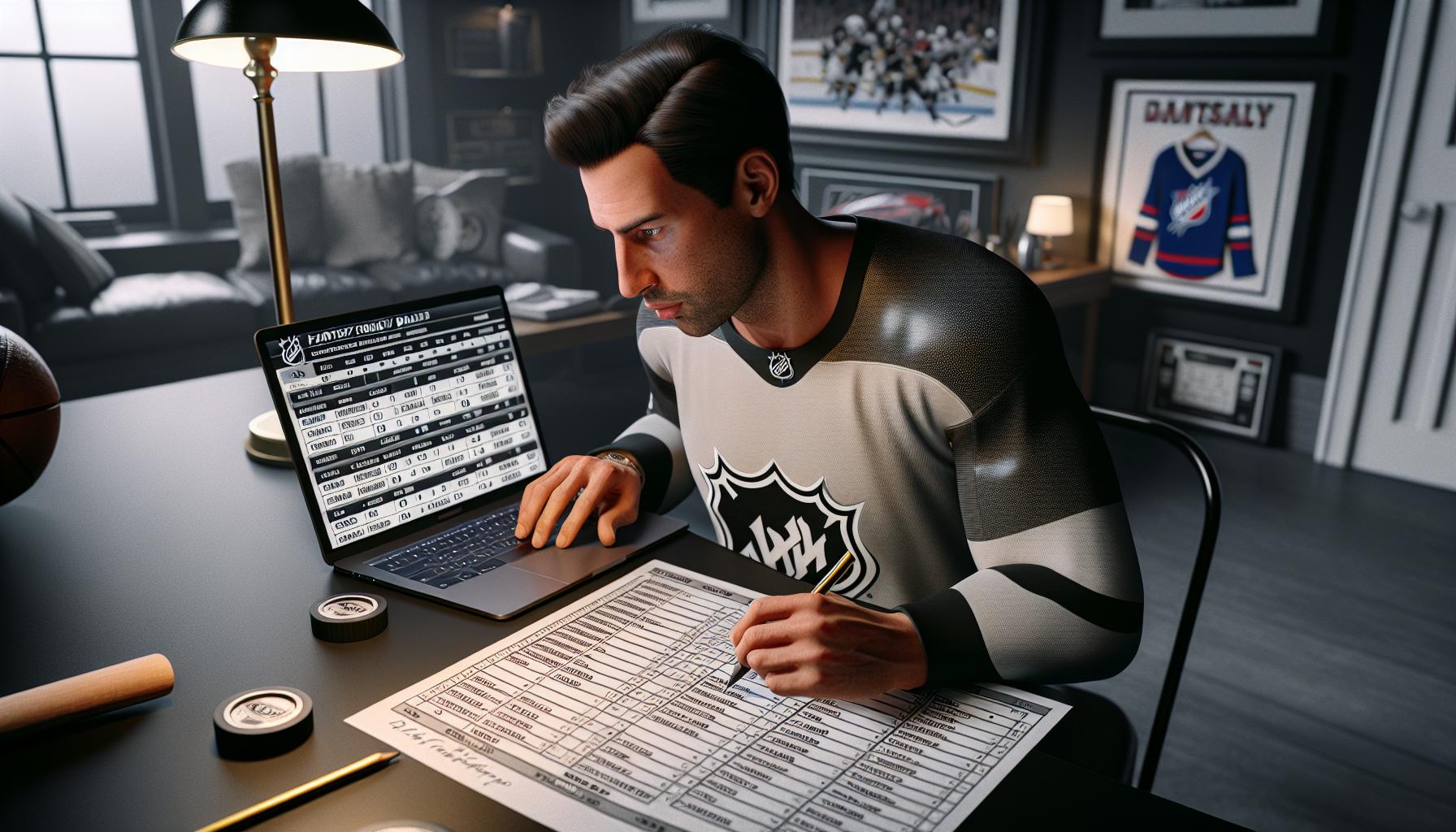Phone:
(701)814-6992
Physical address:
6296 Donnelly Plaza
Ratkeville, Bahamas.

Getting ready for fantasy hockey season can feel like trying to solve a Rubik’s cube while skating backwards. With countless player stats, injury reports and line combinations to consider it’s enough to make any fantasy manager’s head spin faster than a Pavel Datsyuk deke.
That’s where a well-crafted fantasy hockey cheat sheet becomes your secret weapon. Think of it as your personal playbook – a comprehensive guide that breaks down everything from sleeper picks to proven stars. Whether you’re a seasoned veteran or a rookie hitting the virtual ice for the first time you’ll need reliable intel to draft a championship-caliber team.
Fantasy hockey scoring systems determine how players earn points based on their real-world performance metrics. These systems form the foundation of league competition by translating NHL statistics into fantasy points.
Standard fantasy hockey categories include goals (G), assists (A), plus/minus (+/-), penalty minutes (PIM), powerplay points (PPP) shots on goal (SOG). Categories leagues award weekly wins based on head-to-head category victories. Custom leagues modify these standard categories by adding specialized stats like hits blocks faceoff wins or short-handed points.
| Category Type | Common Scoring Elements |
|---|---|
| Standard | G, A, +/-, PIM, PPP, SOG |
| Custom | Hits, Blocks, FOW, SHP |
Point-based leagues assign specific values to each statistical category. Goals typically earn 2-3 points while assists generate 1-2 points in most formats. Powerplay points receive bonus multipliers ranging from 0.5 to 1 additional point. League settings dictate category weights through customized point values.
| Stat | Typical Point Value |
|---|---|
| Goals | 2-3 points |
| Assists | 1-2 points |
| PP Points | 0.5-1 bonus |
| Shots | 0.1-0.2 points |

Effective fantasy hockey draft strategies combine position analysis with tactical player selection to maximize team value. Understanding positional depth charts coupled with player availability patterns creates a competitive advantage in fantasy drafts.
Elite goal-scoring centers provide stability at forward positions in fantasy hockey drafts. Right wings present the most scarcity among forward positions, with only 8-10 premium options available in standard leagues. Quality defensemen become scarce after the first 15-20 selections, making early investment crucial for balanced roster construction. Top-tier goalies typically occupy spots in the first three rounds due to limited availability of clear-cut starters.
| Position | Premium Options | Typical Draft Range |
|---|---|---|
| Centers | 20-25 | Rounds 1-5 |
| Right Wings | 8-10 | Rounds 1-3 |
| Left Wings | 15-18 | Rounds 1-4 |
| Defensemen | 15-20 | Rounds 1-4 |
| Goalies | 10-12 | Rounds 1-3 |
Early draft positions (picks 1-4) favor selecting elite forwards who contribute across multiple categories. Middle draft positions (picks 5-8) offer flexibility to target undervalued defensemen or goalies. Late draft positions (picks 9-12) benefit from the double-pick advantage at the turn, enabling strategic position stacking.
| Draft Position | Primary Target | Secondary Focus |
|---|---|---|
| Early (1-4) | Elite Forwards | Power Play Specialists |
| Middle (5-8) | Top Defensemen | Multi-Category Players |
| Late (9-12) | Position Stacking | High-Upside Goalies |
Elite players form the foundation of successful fantasy hockey teams through consistent high-level production across multiple scoring categories. These top-tier talents deliver reliable performance metrics that anchor championship rosters.
Connor McDavid leads the elite forward tier with 150+ point potential. Nathan MacKinnon follows in the premium tier, projecting 110+ points with high shot volumes. Leon Draisaitl sits in the elite scoring tier, combining 50+ goal potential with powerplay dominance. The top forward tiers include:
Cale Makar anchors the elite defensemen tier with 80+ point upside. Igor Shesterkin leads the goalie rankings with elite ratios across all categories. The defensive tiers feature:
| Position | Tier 1 Avg Points | Draft Round Range |
|---|---|---|
| Forwards | 120+ | Rounds 1-2 |
| Defense | 70+ | Rounds 2-3 |
| Goalies | 35+ wins | Rounds 2-4 |
Identifying undervalued players and potential breakout stars creates a competitive advantage in fantasy hockey drafts. These hidden gems offer significant value relative to their average draft position.
Logan Thompson emerges as a prime late-round target, posting a .915 save percentage in 37 games for Vegas last season. Pavel Zacha’s promotion to Boston’s top-six forwards positions him for increased production at a bargain draft price. Seth Jarvis maintains steady ice time on Carolina’s first powerplay unit, making him an attractive option in rounds 14-16. Kent Johnson’s expanded role in Columbus creates scoring opportunities while requiring minimal draft capital investment. Additional value picks include:
Tracking player injuries affects fantasy hockey draft strategies by impacting player availability. Real-time monitoring of injury updates helps managers make informed decisions during drafts.
Key players with current injury concerns include Gabriel Landeskog (knee surgery) missing the entire 2023-24 season. Josh Anderson (ankle) faces a 6-8 week recovery timeline while Sean Couturier (back) remains questionable for season start. Tom Wilson (ACL recovery) projects a late October return based on medical reports. Additional players under medical observation:
| Player | Injury Type | Expected Return |
|---|---|---|
| Matt Murray | Hip | Out indefinitely |
| Jake DeBrusk | Lower body | Day-to-day |
| Tyler Bertuzzi | Hand | Early November |
| Morgan Rielly | Knee | Late October |
Teams implement strategic rest schedules for veteran players especially during back-to-back games. Sidney Crosby receives planned maintenance days throughout the season reducing his game appearances. Marc-Andre Fleury sees decreased starts due to age-related workload management. Teams limit ice time for:
| Player | Rest Pattern |
|---|---|
| Alex Ovechkin | Skip morning skates |
| Erik Karlsson | Reduced back-to-backs |
| Anze Kopitar | Limited practice days |
| Carey Price | Alternate game starts |
Players returning from significant injuries face restricted minutes including Nathan MacKinnon Matt Duchene Sam Bennett during their initial games back.
Executing a successful fantasy hockey draft requires meticulous preparation coupled with adaptable strategies during the live draft. These tactical approaches maximize draft efficiency while minimizing decision-making pressure.
Mock drafts provide essential insights into player selection patterns across different draft positions. Fantasy managers gain valuable experience by participating in 3-5 mock drafts before their actual draft date. Testing various draft positions reveals optimal player combinations for each round. Popular platforms like Yahoo Sports ESPN offer free mock draft lobbies with realistic draft scenarios. Recording average draft positions trends helps identify potential steals in later rounds. Practicing draft queue management streamlines the selection process during time-sensitive picks. Mock drafts also expose position runs allowing managers to anticipate roster construction challenges.
Live drafts demand quick reactions to unexpected player selections roster composition shifts. Managers monitor position scarcity tracking the number of remaining elite centers defensemen goalies in each round. Creating multiple contingency plans accommodates sudden changes when targeted players get selected. Draft room chat messages reveal competing managers’ strategies enabling tactical counter picks. Position flexibility increases as the draft progresses allowing value-based selections in later rounds. Identifying reaching patterns helps predict upcoming selections in snake drafts. Trading draft positions provides opportunities to target specific players in optimal draft slots. Draft queue maintenance ensures smooth transitions between picks during short time windows.
A well-crafted fantasy hockey cheat sheet is the cornerstone of draft day success. Armed with comprehensive player rankings tier breakdowns and strategic insights managers can navigate their drafts with confidence. By staying informed about injuries monitoring breakout candidates and understanding position scarcity they’ll be better equipped to build championship-caliber teams.
The key to fantasy hockey success lies in thorough preparation and adaptability during the draft. Whether targeting elite talents like McDavid and MacKinnon or uncovering hidden gems in later rounds a solid cheat sheet serves as an invaluable roadmap to fantasy hockey glory. It’s time to put this knowledge into action and dominate the fantasy hockey season.